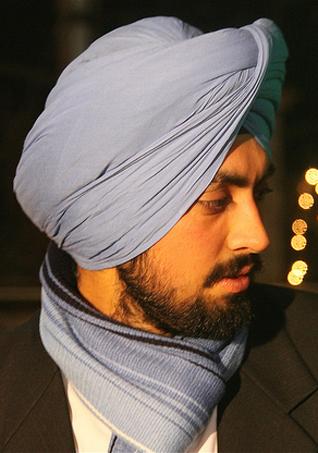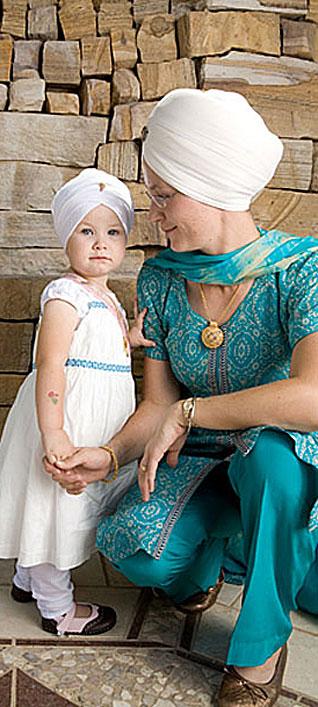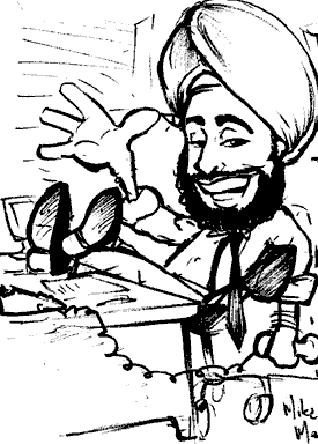Resource Library
The Sikh Turban
by GURMUKH SINGH (U.K.)
“Originally, I wore the turban for my religion. Then for my family. Now I wear it for myself.”
[Ravi Singh, U.S.A.]
“There must be no doubt that the long coiled hair and the turban go together as one of the five K’s; as they are called, of the articles of the religion dating back over 500 years. Definitions have been clearly made by the gurus from time to time.”
[Sydney Bidwell, M.P. (Ealing-Southall) speaking in the House of Commons on 28 January, 1975. Ref: His book, “The Turban Victory”.]
For a Sikh, the dastaar (Sikh turban) is a religious requirement by the Guru’s own injunction. Dastaar is an essential article of faith for male Sikhs, about that there should be no misunderstanding: men must wear it, while it is optional for women.
Of the numerous quotations which
are available, two are given below from writers who were with Guru
Gobind Singh. The third quotation is from the “Sikh Reht Maryada
– The Code of Sikh Conduct & Conventions”, as approved by the Khalsa
Panth. So far as the Sikhs are concerned, all other arguments based on
culture and tradition are of secondary importance.
kangha dono wakt kar/ paag chuneh kar baandh
"Comb your (unshorn) hair twice a day and tie your turban neatly.
[Tanhkahnama of Bhai Nand Lal - a leading poet in Guru Gobind Singh’s court.]
joora sis kay madh baandhe(n)/ aor paag barhi baandhe(n)
"Tie your hair-knot in the middle of your head and tie the full length
turban (to distinguish it from the small turban called “keski” which
some Sikhs wear underneath the full length turban).
[Rehat Naama Bhai Daya Singh - the first of the Punj Pyare - the Five Beloved Ones.]
huto guru sri jaani jaan/ sabhi bidhee guru leyee pehchaan …
sehli topi sir dhare(n)/ daaseh naam kahai …
ab sikhan roop paltaiyay/ tej dhari jim lakh tao pai …
shatri roop sundar att laagay/ kes sis sir bandhio paagay …
"And so the All-Knowing Guru recognised the need … these people wear a cap
and have names like “Das” (slave or servant) … now the appearance (and
personality) of the Sikhs will be changed and they shall be recognized
in their distinctive glamour amongst thousands. The (saint-) warrior
appearance is attractive with unshorn hair and turban tied on the head.
[“Sri Guru Panth Prakash” by Bhai Ratan Singh Bhangu]
“For
a Sikh, there is no restriction or requirement as to dress except that
he [or she] must wear Kachhehra [a drawer type of garment] and turban. A
Sikh woman may or may not tie a turban.” [Panth approved “Sikh Rehat
Maryada - The Code of Sikh Conduct & Conventions”.]
I was very much impressed when Dya Singh of Australia (who needs no introduction) first showed me the photograph of young dastaar-dhari, sabat-surat Ravi Singh with President George Bush, who had his friendly arm over Ravi’s shoulder.
"Originally, I wore the turban for my religion. Then for my family. Now I wear it for myself," wrote Ravi Singh of U.S.A.
Born and raised as a Sikh-American in Illinois, he graduated from Marmion Military Academy. He made history by becoming the first U.S. cadet ever to graduate from a military academy with a turban. And read on!
“He’s been an aide to the Lieutenant Governor and State Treasurer of Illinois, a student body President, an NCAA Division I golf captain, a candidate for public office, a community activist, involved in two presidential campaigns, an international lecturer, and business entrepreneur.”
And he has written “Leadership by Turban - An American Story”, which is a “must read” for all Sikh youth.
“Discovering your roots is the key to half your identity. The rest is up to you”, is Ravi’s experience.
It
becomes rather tedious reading Sikh scholars quoting the Old Testament:
“Once they enter the gates of the inner Court, they are to wear
vestments. They shalt wear linen turban, and linen drawers on their
loins.”
So what, I ask myself. Is it not enough that my Guru instructed
me to wear a turban over my unshorn hair? In the same vein, references
by Sikh scholars to Samson and myths about the power of hair do sound
quite ridiculous!
However, we can accept that for thousands of
years the turban had, and for millions around the world continues to
have, very special cultural and spiritual significance. In the Semitic
traditions - the Jewish, the Christians and the Islamic - the turban has
been a symbol of “prophethood, holiness and divine power.” [The Turban
and the Sword of The Sikh by Dr. Trilochan Singh].
It matters not
whether “one of the commands of God to Moses was to wear a turban …”
Also,
in India, the turban was and continues to be, a symbol of royalty,
being used in place of a crown. The Sikh dastaar makes the Sikh a Sardar (chief or lord). Without a dastaar, a Sikh is not a sardar, and no one addresses him so. The Sikh dastaar, worn neatly and with dignity, does combine and represent the miri-piri (temporal and spiritual) aspects of Sikhi.
in gareeb sikhan ko dioon paatshahi
- "I shall bestow royalty on these poor Sikhs" was the Guru’s promise.
And so, by replacing their servile topis (caps) with the kingly turban,
and by placing the sword of honour - the defender of human dignity - in
their hands, that is precisely what the Guru did.
Within sixty
years of the Guru’s demise, the Sikhs ruled all the area north of Delhi
and put a stop to the annual invasions from the north-west via
Afghanistan.
Sikh Turban ban in France
An
article on dastaar would not be complete without a reference to the
turban issue in France. As Dr. M.S. Rahi says in his well researched
article in “The Sikh Review” [Turban and the French Law, Jan 2005):
“The turban of the Sikhs, a hoary article of their faith, is once again
caught in the controversy of definition of secularism as understood
within the framework of French republicanism and political liberalism of
the other countries of the world.”
According to Universal
Declaration of Huamn Rights, “Everyone has the right to freedom of
thought, conscience and religion; this right includes … either alone or
in community with others and in public or private, to manifest his
religion…” [Article 18].
The French passed a law which contravenes a
human right agreed at the international level. In fact the French are going
against the spirit of their own constitution. It was the French
Revolution which gave the world the famous slogan - liberty, equality
and fraternity. As is accepted, if the Sikh dastaar “is a symbol of
dignity, freedom and moral courage to fight against injustice facing all
the odds and difficulties”, then the French ban is a challenge for the
Sikhs worldwide, to resist such injustice. The Sikhs should continue to
seek the support of the international community.
Writes Dr. M.S.
Rahi: “The international community should take note that the Sikhs are
feeling hurt and humiliated by the French Law passed in the 21st century for
the removal of their turban in the schools of France.”
Sikh
youth today are looking for extrovert role models like Dya Singh of
Australia and Ravi Singh of U.S.A., who are proud of their Guru-given
dastaar and Sikh identity. Over the years, hundreds of turban-wearing
Sikhs around the world have succeeded and excelled in their chosen
professions. The dastaar, as part of the saabat-surat Sardar Sikh
personality, gave them the strength of character and the courage to face
all odds and to succeed. That is also my personal experience of living
and working in the U.K. for 50 years.
The dastaar, as part of the Sikh identity, is a gift of the Guru and should be accepted gratefully as such.
The 21st Century message for Sikh youth is: "Leadership by Turban” is not a theory but a proven fact.
I started with a quotation from the a speech in the House of Commons, let me finish with one from the House of Lords:
"There is absolutely no doubt that the wearing of the turban is an essential part of the Sikh religion. The Ten Gurus, the founders of the religion and the architects of it, all wore the turban themselves." [Lord Avebury, October 5, 1976 - Second Reading of the “Motor-cycle Crash-Helmets (Religious exemption) Bill”.]
June 25, 2011
Conversation about this article
1: Roop (Reigate, United Kingdom), June 25, 2011, 10:23 AM.
The beautiful dastaar ... How I envy those who wear it. Especially those Sikhs who are ambassadors for the panth. I don't mean the ones who drink alcahol and smoke and appear Sikhs outwardly. I am a very proud Punjabi, but on s faith level I shine with pride when I see a well dressed turbaned Sardar or Sardarni. What I find ironic is how we as Indians are often told Whites and Pakistanis are the enemy. The latter are so with us re Punjabi culture. And the former we have sullied too long. Think about it, has a Sikh ever received as much respect in India as in the West (9/11 not withstanding)? First 1947, then 1984. Yet we Sikhs get a better life protected by law in the West. It's time we recognise that Sikhism can thrive better in the West. All we need is educate then about our dastaar.
2: Ajit Singh (Winnipeg, Manitoba, Canada), June 25, 2011, 10:29 AM.
Escellent. Carry on ...
3: H.S. Vachoa (U.S.A.), June 25, 2011, 1:38 PM.
I don't understand that if we as Sikhs wear a turban as a requirement, then how do we have liberty?
4: Jasbir Kaur (Kentucky, U.S.A.), June 25, 2011, 2:48 PM.
Simple, H.S. Vachoa ji: the same way you enjoy American liberty while having to follow the rules of the road and being required to drive on the right side of the road.
5: Ravinder Singh Taneja (Westerville, Ohio, U.S.A.), June 25, 2011, 4:38 PM.
I share my personal sentiments on tying the turban, written in 1996, soon after becoming an Amritdhari Singh - after years of sporting short hair. The feeling has not diminished, if anything it is more intense: Tying the turban has become a daily formality and one that I invest with the same ceremony and courtesy that befits a crown. Indeed, the turban is a Khalsa's crown and the centerpiece of a Sikh's identity. Turban tying is central to my morning routine and I approach it with the utmost reverence. Like a crown, my turban is not worn or removed casually. Unlike donning a hat, I wrap my turban daily with delicate attention to any wrinkles that must be ironed out. On occasion, a stubborn fold, or laR, will defy me. That is when I practice the virtue of patience (not always successfully) and redo the fold until it meets expectations. Of course, that causes me to miss my regular train on the Long Island Railroad. But I know my priorities: a Khalsa is not to give in to an errant "laR" or leave home with a sloppily-tied turban. There will always be another train. The end result is almost always gratifying. As I catch that last look in the mirror before leaving home, I am overcome with a keen sense of connection to a noble faith and tradition, a deep feeling of gratitude and obligation to the Guru for investing me as "Sant-Sipahi". My new look is electrifying. I am quite unrecognizable, and yet, in my new incarnation, very recognizable. There is no confusion as to who I am and what I stand for. I leave the house with praise for the Guru on my lips, a swagger in my gait and a new challenge in my eyes. I am proud to be a Khalsa.
6: H.S. Vachoa (U.S.A.), June 26, 2011, 2:39 PM.
It is not clear to Sikhs themselves that why we should wear a turban. Calling it a requirement undermines the human choice and ends up provoking guilt amongst many Sikhs. This doesn't work and it will never work. This is the reason why so many Sikhs don't wear one as it is more of an imposition and less of a choice. Shouldn't people have liberty in making a choice?
7: Gurjender Singh (Maryland, U.S.A.), June 26, 2011, 10:10 PM.
H.S. Vachoa ji: no one can, no one should, no one does force any one to wear a turban. There is an old saying that a person can take a horse to the river very easily but even 10 people cannot make him drink water from river, it it doesn't want to. There are so many religions in the world. Just remember that 7 and 9 year old children of Guru Gobind Singh were buried alive in a brick wall for not accepting conversion. On the other hand, Guru Teg Bahadar was beheaded to save the right of people to practice another religion. Our Gurus never forced anyone; it is your choice. It is Sikhs and their leadership's fault that they failed to teach the West (or even in India) about Sikhi and the turban by use of modern media. Look at Guru Gobind Singh on the Vaisakhi Day of 1699 - history says that there was a gathering of tens of thousands of people from across the subcontinent, when in those days today's communication facilities were non-existent.
8: Pardeep Singh (Canada), June 27, 2011, 5:47 PM.
Just a quick response to H.S. Vachoa: the choice is the freedom to choose your religion. You can't have or ask for the liberty to choose a religion and then want additional liberty to pick and choose to follow a few principles or not, whenever or however convenient or inconvenient. The turban for Sikhs is itself a choice of liberation for all, as it wasn't in the historical religious and social context, and even today where only certain members of a faith are allowed to adorn themselves with a head covering, and in some practices only certain class/ caste as a status symbol wear turbans. The turban for me represents my freedom of choice of faith and the freedom to practice the principles of social justice and human rights, all at the same time holding me publicly accountable and publicly reaffirming my duty to serve and protect.
9: Sokhi (United Kingdom), August 06, 2011, 11:13 AM.
May the turban be of truth, May the colour be of compassion, May the folds be of faith, May the cloth be a soft heart, May the straightness be thy word, May the style be eternal.
10: R. Singh (Canada), October 24, 2011, 4:42 AM.
Sokhi Ji, you have hit the nail on the head! "May the turban be of truth, May the colour be of compassion, May the folds be of faith, May the cloth be a soft heart, May the straightness be thy word, May the style be eternal." Those who seek to malign and marginalise others on the same path of Sikhi with their attitude, let them inspire with such a turban.
11: Japji Kaur (Connecticut, U.S.A.), October 24, 2011, 7:03 AM.
Dear Sokhi ji and R. Singh ji: So beautifully put! But don't forget - this doesn't mean you are to knock your own turban off. All it means is that you are to wear your turban with pride, AND while doing so, practice everything it represents ... fully!





